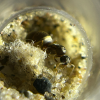Pretty sure this is fusca group, but I would rather have people more experienced than me come to a conclusion.
I know its probably quite hard to nail a species down, but I'm guessing this is subsericea.
Approximately 10mm.


Best Answer Mettcollsuss , August 1 2024 - 11:41 AM
Formica fusca group, almost certainly subsericea, however there are some rarer species that cannot be definitively ruled out. We would need to see the relative density of the pubescence on the third and fourth tergites and/or the presence or absence of large punctures on the malar area in order to distinguish it from F. argentea, and the relative density of the gaster pubescence and pilosity to separate from species like subaenescens, podzolica, or glacialis.
Go to the full post
Wow she looks aggressive in that first photo! And pretty fat with food! Formica subsericea is my guess.
Manica invidia (1 queen, ~200 workers)
Manica invidia (1 colonies, 1 queens plus 3 workers)
Lasius niger (single queen, ~200 workers - naturalistic, predatory set-up)
Lasius americanus (1 colony, ~10 workers)
Tetramorium immigrans (3 colonies, 3 queens, ~ five workers each | 1 colony, 1 queen, ~1200 workers)
Formica aserva (aserva queen, ~15 Formica neorufibarbis workers)
"And God made...everything that creeps on the ground according to its kind.
And God saw that it was good." - Genesis 1:25
Keeping:
5x - S. molesta (founding) 2x - C. pennsylvanicus (colonies)
4x - C. chromaiodes (colonies)
4x - T. immigrans (founding queens and colonies)
1x - F. subsericea (founding)
Check out my C. nearcticus journal here: https://www.formicul...cticus-journal/
Check out my C. chromaiodes journal here: https://www.formicul...aiodes-journal/
If it’s any help in direct sunlight the gaster is highly silver in color.It could also be F. neogagates but I don't see any silver band on the gaster from these pics indicating F. subsericea. Although it still could be F. subsericea.
Then yeah that's definitely F. subsericea (as from what I know, F. neogagates is a completely solid color with no silver effect to the gaster. The setae on their gaster comparatively is the same exact as F. subsericea at least to the naked eye).If it’s any help in direct sunlight the gaster is highly silver in color.It could also be F. neogagates but I don't see any silver band on the gaster from these pics indicating F. subsericea. Although it still could be F. subsericea.
Keeping:
5x - S. molesta (founding) 2x - C. pennsylvanicus (colonies)
4x - C. chromaiodes (colonies)
4x - T. immigrans (founding queens and colonies)
1x - F. subsericea (founding)
Check out my C. nearcticus journal here: https://www.formicul...cticus-journal/
Check out my C. chromaiodes journal here: https://www.formicul...aiodes-journal/
I did find the queen in a field woodland border, with a marsh nearby. I don’t know if that’s any indication of species however.Then yeah that's definitely F. subsericea (as from what I know, F. neogagates is a completely solid color with no silver effect to the gaster. The setae on their gaster comparatively is the same exact as F. subsericea at leastIf it’s any help in direct sunlight the gaster is highly silver in color.
It could also be F. neogagates but I don't see any silver band on the gaster from these pics indicating F. subsericea. Although it still could be F. subsericea.
to the naked eye).
Keeping:
5x - S. molesta (founding) 2x - C. pennsylvanicus (colonies)
4x - C. chromaiodes (colonies)
4x - T. immigrans (founding queens and colonies)
1x - F. subsericea (founding)
Check out my C. nearcticus journal here: https://www.formicul...cticus-journal/
Check out my C. chromaiodes journal here: https://www.formicul...aiodes-journal/
Currently keeping:
1x Formica subsericea, 35-40 workers + maybe eggs
1x Crematogaster cerasi, only queen now, workers ded ![]() *internal screaming*
*internal screaming*
1x Myrmica ruba sp around 10 workers + pupa
*New* 1x founding Camponotus pennsylvanicus + eggs that die (probably infertile)
*New* 2x Camponotus nova, one is infertile
*As you watch your ants march, remember that every thing begins with a small step and continued by diligence and shared dreams*
-A.T (which is Me)
Formica fusca group, almost certainly subsericea, however there are some rarer species that cannot be definitively ruled out. We would need to see the relative density of the pubescence on the third and fourth tergites and/or the presence or absence of large punctures on the malar area in order to distinguish it from F. argentea, and the relative density of the gaster pubescence and pilosity to separate from species like subaenescens, podzolica, or glacialis.
Formica fusca group, almost certainly subsericea, however there are some rarer species that cannot be definitively ruled out. We would need to see the relative density of the pubescence on the third and fourth tergites and/or the presence or absence of large punctures on the malar area in order to distinguish it from F. argentea, and the relative density of the gaster pubescence and pilosity to separate from species like subaenescens, podzolica, or glacialis.
Even though it doesn't matter, I probably will take pictures of those regions you listed and post it here. If you do reread this thread and find the pictures then it would be cool to know exact species if the pictures are adequate.
0 members, 1 guests, 0 anonymous users